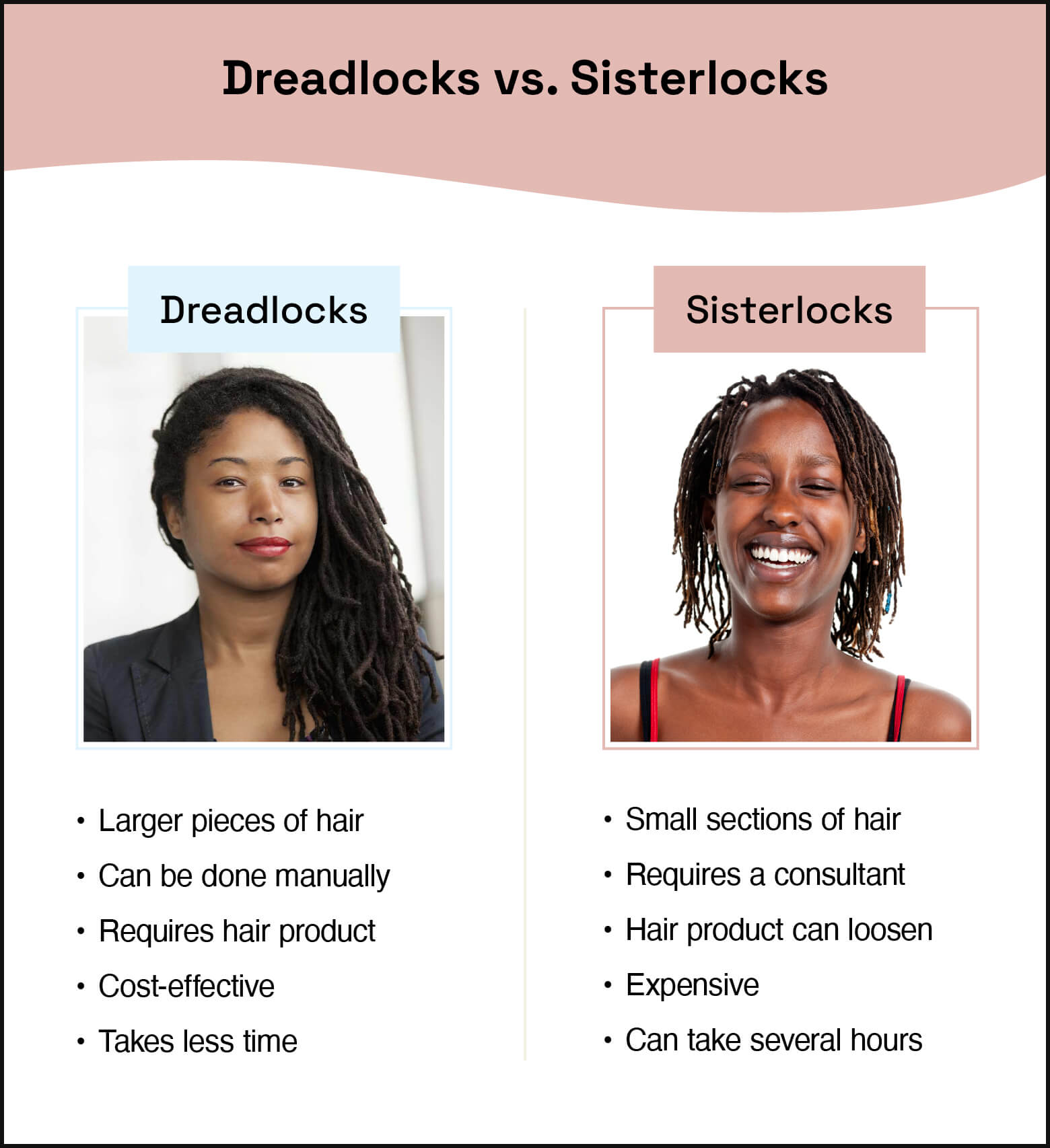What Are Sisterlocks? Your Complete Guide

Hairstyles that complement natural hair and show off your personality are always a great everyday option. If you’re looking for a protective style that also gives you the freedom to experiment with hair color trends, try Sisterlocks.
If you’re wondering what Sisterlocks are and if this hairstyle is right for you, you’ve come to the right place. Keep reading to learn all you need to know about this hairstyle, including the difference between Sisterlocks and dreadlocks and how Sisterlocks are installed.
What are Sisterlocks?
Dr. JoAnne Cornwell created Sisterlocks back in 1993; her primary focus was to find a way for women of color to create a healthy style for their hair that did not use harsh chemicals or extensions. This style remains very popular today due to the low maintenance required and the versatility.
Sisterlocks can be likened to micro braids, miniature-sized dreadlocks, or simply small locs. Sisterlocks are installed using the interlocking method and typically range from one-eighth inch to three-eighths inches in width. Generally, most people end up with 250 to 400 Sisterlocks; if you prefer smaller Sisterlocks, you might end up with more.
Unlike other hairstyles like dreadlocks, which are hand-rolled or twisted with hair products like wax, Sisterlocks are weaved into the hair with a tool that essentially builds the locs from the ends of the hair to the root.
Is there a difference between Sisterlocks and dreadlocks?
There are a few key differences when it comes to Sisterlocks and traditional dreadlocks. First, the sizes are very different — Sisterlocks are significantly smaller than traditional locs. In addition, traditional dreadlocks are created through techniques like rolling, twisting, or coiling, whereas Sisterlocks are installed with a special tool that starts the style at the ends of your hair (versus at the root with dreadlocks).
Traditional locs can be done at home and are rather easy to maintain, whereas Sisterlocks are typically done by certified associates (since the process is trademarked). Finally, the price between the two styles varies drastically. For traditional locs, costs can range from $50-$100 for the starting and maintenance appointments. For Sisterlocks prices, installation can range from $500-$2,500, with maintenance costs being around $150-$200 per appointment.

Who can get Sisterlocks?
Sisterlocks were specifically designed for those with naturally curly or coiled hair textures. If your hair has been relaxed, you can also get the Sisterlocks style. Sisterlocks work on fine or thin hair, though those with damaged hair should skip this style, as locking it will only make the damage worse. If your hair is damaged, consider letting it grow for a while before having Sisterlocks installed.
Sisterlocks installation
The installation of Sisterlocks is a bit more time-consuming than traditional dreadlocks. There are three distinct steps that need to be taken, and these typically span over a few days. Sisterlocks are installed by certified consultants, and while each salon and consultant might take their own unique steps, they’ll likely follow the general process below. Before booking an appointment, take the time to get familiar with the installation process:
Step 1: Consultation
The first Sisterlocks visit will be a consultation in which you’ll meet with a certified consultant. You’ll be able to discuss questions, get a feel for how many Sisterlocks you’ll have, and have an opportunity to learn more about the process. During the consultation, the consultant will typically install between five and 10 Sisterlocks in your hair to help determine the best pattern for full installation.
Step 2: Installation session
After your consultation, your consultant will start the full installation. This step can take anywhere from 15 to 24 hours, depending on your hair length, your head size, and the density of your hair. Because of the time requirement, your consultant will most likely spread this out over multiple sessions. This process includes a few key steps:
- Hair sectioning: Your consultant will section your hair to prep for installation. While each Sisterlocks consultant has been trained to be systematic in the way they section your hair, each consultant might have their own unique variation.
- Parting: Once your hair has been sectioned, the consultant will part each larger section into rows. This will provide a guide for the consultant when installing the Sisterlocks.
- Installation: The consultant will use a patented tool to interlock the small sections of your hair from tip to root.
Step 3: Follow-up appointments
Once your consultant has installed your Sisterlocks, you’ll need to be diligent to maintain them. Scheduling a follow-up appointment is crucial to make sure that all of the Sisterlocks are set and to make any changes if needed. They will also fill you in on any maintenance tips that you can do yourself. Going forward, you’ll need to see your consultant every four to six weeks to retighten your Sisterlocks as they grow out.

Sisterlocks pros and cons
When deciding if Sisterlocks are best for you, it helps to make a list of pros and cons, especially since this can be an expensive process. Below are a few considerations:
Pros
- Minimal products: Unlike traditional locs, Sisterlocks don’t require a lot of product to be used on the scalp and hair, minimizing buildup.
- Freedom: The only maintenance Sisterlocks need is routine retightening, making it a low-maintenance style. Additionally, there’s no need to worry about the rain, as these locs air dry easily after becoming wet.
- Versatile: Sisterlocks can be styled in a variety of ways, meaning you can change your look with ease!
- Customized: Due to the way they’re installed, Sisterlocks are often considered “designer locs” and can be customized to your specific hair texture.
Cons
- Cost: It’s no secret that Sisterlocks can be costly. Between the initial consultation, the installation, and the maintenance, the cost of Sisterlocks can definitely add up.
- Time: Not only does the initial installation appointment take a significant amount of time, but the maintenance appointments take time as well. Furthermore, your hair might take time to grow in length if breakage occurs.
- Location: Because this is a patented process, it’s vital to find a Sisterlocks consultant to install your new style. Depending on your location, this might mean traveling to have them initially installed and for regular appointments.
Sisterlocks hairstyles
Part of the appeal of Sisterlocks is their versatility. With shorter Sisterlocks, you might not be able to pull them back into a ponytail, but as they grow, you can try up-dos, braided styles, curls, and even experiment with highlights. In terms of versatility, Sisterlocks are often preferred over traditional dreadlocks. Below are some common Sisterlocks styles that can easily add personality to your look:

Sisterlocks FAQs
The decision to have Sisterlocks installed is not one that should come lightly — after all, it does take time, money, and dedication to keep them maintained. Before you decide on this process for your hair, take some time to get familiar with the most common questions.
How much do Sisterlocks cost?
The cost of installation and maintenance can vary based on location. However, you can usually expect to pay anywhere between $500 and $2,500 for installation. This is based on several factors, including the Sisterlocks size, the length of your hair, and the consultant you choose.
Another factor to consider is maintenance. After the installation, your natural hair will continue to grow, which will need to be incorporated into each loc. These appointments can cost anywhere between $150 and $200 every four to six weeks.
How long do Sisterlocks last?
While Sisterlocks can be undone, they are meant to be more of a permanent hairstyle, allowing them to mature over time. If you want to have them removed, the easiest time is within the first six months. After this initial period, the process of removing them (without cutting them off) can be somewhat tedious. If you’re not sure that Sisterlocks are right for you, consider speaking with the consultant during your consultation to raise any concerns you might have.
Remember that your Sisterlocks will need to be retightened roughly every four to six weeks as your hair grows. While it is suggested that you head to the salon for every appointment, classes are available on how to retighten your Sisterlocks at home, though it’s advisable to only go this route after the first six months.
Do Sisterlocks damage hair?
Unlike traditional dreadlocks that require hair products to style and maintain, Sisterlocks require no chemicals, products, or abrasion to achieve the desired look. In fact, breakage and overall weakened hair are brought on by the neglect of your Sisterlocks, not because of them.
For example, if you are retightening infrequently, breakage could occur. Similarly, if you are retightening too frequently, this could in turn weaken your Sisterlocks. For best results, speak with your Sisterlocks consultant about the appropriate frequency of appointments.
How do you care for Sisterlocks?
With such a time and energy investment, it’s no surprise that you’d want to take care of your Sisterlocks in between appointments. Below are some common tips on how to care for your new style. Remember to follow up with your consultant on the best care for your hair specifically, as all hair is different.
- Wash and condition: Similar to any natural hairstyle, a solid hair care routine is key to keeping your hair happy and healthy. Typically, consultants recommend washing every one or two weeks and will provide you with information on the correct shampoo to use and the best way to wash your hair.
- Minimize the heat: Air drying your Sisterlocks is a great way to keep your hair looking and feeling healthy. Excessive heat can damage your hair and make your Sisterlocks look frayed, and may even cause them to lose their shape. After six months, you can start to use low heat to style.
- Add nourishment: If your Sisterlocks are feeling dry, feel free to add a few drops of a nourishing serum to hydrate your hair and keep it looking shiny. Just make sure to speak with your consultant first, as using hair products before six months can impact the overall look of your coils.
- Wrap your hair at night: Consider wrapping your hair in a silk or satin bonnet when you sleep to protect your hair from breakage and tangles.
Are Sisterlocks permanent?
Sisterlocks are meant to be permanent, though it is possible to have them uninstalled or cut off. The process of uninstalling and combing them out can be very time-consuming, which is why many opt to cut them off instead if they want them removed.
Sisterlocks are a fun and stylish take on the traditional dreadlocks hairstyle. If you’re looking for something permanent that has versatility, Sisterlocks might be for you. If you’re on the fence, consider setting up a consultation with a Sisterlocks consultant to answer any questions you may have before starting the process.
Check out our directory of Sisterlocks consultants to find someone who works best with your hair goals and budget.


